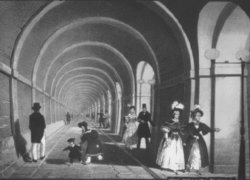Thames Tunnel
|
|
The Thames Tunnel is a tunnel, 35 feet wide and 1,300 feet long, beneath the River Thames in London, between Rotherhithe and Wapping. Originally constructed for pedestrian use, it is currently used by trains of the London Underground's East London Line. It was built by Marc Isambard Brunel and his son Isambard Kingdom Brunel in the 19th century.
A previous attempt at construction by Richard Trevithick in 1808 failed due to the difficult conditions of the ground. Marc Brunel's approach at the start of the project in January 1825 was to begin by digging a large shaft on the south bank at Rotherhithe. He did this by first building a brick cylinder above ground and then gradually sinking it by removing the earth beneath it.
Brunel and Thomas Cochrane devised the tunnelling shield to dig the tunnel. The Illustrated London News of 25 March 1843 described how it worked:
- "The mode in which this great excavation was accomplished was by means of a powerful apparatus termed a shield, consisting of twelve great frames, lying close to each other like as many volumes on the shelf of a book-case, and divided into three stages or stories, thus presenting 36 chambers of cells, each for one workman, and open to the rear, but closed in the front with moveable boards. The front was placed against the earth to be removed, and the workman, having removed one board, excavated the earth behind it to the depth directed, and placed the board against the new surface exposed. The board was then in advance of the cell, and was kept in its place by props; and having thus proceeded with all the boards, each cell was advanced by two screws, one at its head and the other at its foot, which, resting against the finished brickwork and turned, impelled it forward into the vacant space. The other set of divisions then advanced. As the miners worked at one end of the cell, so the bricklayers formed at the other the top, sides and bottom."
The key innovation of the tunnelling shield was its use of compressed air to keep the working face from flooding. But the dangers of compression and decompression were not understood, and workers soon fell ill from the poor conditions, including Brunel himself; ten men died during the project.
Work was slow, progressing at only 8-12 feet a week. Isambard Kingdom Brunel took over as chief engineer, and when on 18 May 1827 the tunnel flooded, he used a diving bell to repair the hole at the bottom of the river. Following the repairs and the drainage of the tunnel, he held a banquet inside it.
The tunnel was flooded again the following year, 12 January 1828, and the project was abandoned for seven years, until Marc Brunel succeeded in raising sufficient money to continue work. Impeded by further floods and gas leaks (methane and hydrogen sulphide), it was not completed until 1842. It was finally opened to the public on 25 March 1843.
The tunnel was not, however, a financial success and soon acquired an unpleasant reputation due to its adoption by London's prostitutes as a place of business. Nathaniel Hawthorne, writing in 1855, commented:
- "It consisted of an arched corridor of apparently interminable length, gloomily lighted with jets of gas at regular intervals ... There are people who spend their lives there, seldom or never, I presume, seeing any daylight, except perhaps a little in the morning. All along the extent of this corridor, in little alcoves, there are stalls of shops, kept principally by women, who, as you approach, are seen through the dusk offering for sale ... multifarious trumpery ... So far as any present use is concerned, the tunnel is an entire failure."
In 1865 the tunnel was bought by the East London Railway Company and was adapted for trains, which ran out of Liverpool Street station. It was subsequently absorbed into the London Underground. In 1995 it became the focus of considerable controversy when the tunnel was closed for long-term maintenance,with the intention of sealing it against leaks by "shotcreting" it. This led to a legal conflict with architectural interests wishing to preserve the tunnel's appearance and disputing the need for the treatment. Following an agreement to leave a short section at one end of the tunnel untreated, and more sympathetic treatment of the rest of the tunnel, the work went ahead and the route reopened - much later than originally anticipated - in 1998.
Although the tunnel itself cannot usually be visited (except by train), the engine house on the southern bank, which originally housed the pumps to drain the tunnel, has been restored and converted into a museum.
External links
- "Brief history during the Snow era" (http://www.ph.ucla.edu/epi/snow/1859map/thamestunnel_a2.html), UCLA School of Public Health
- The Brunel Engine House Museum, Rotherhithe (http://www.brunelenginehouse.org.uk/)
- Template:GBvosi, published in 1882, actually marks the tunnel


